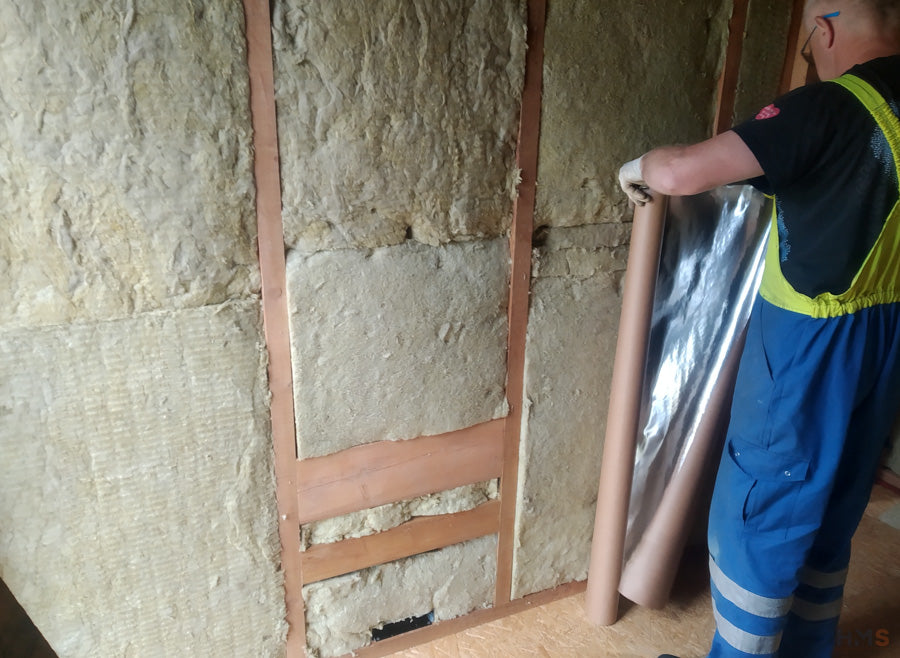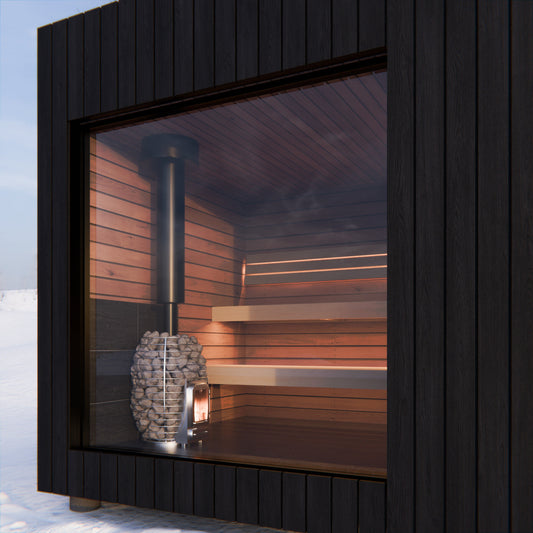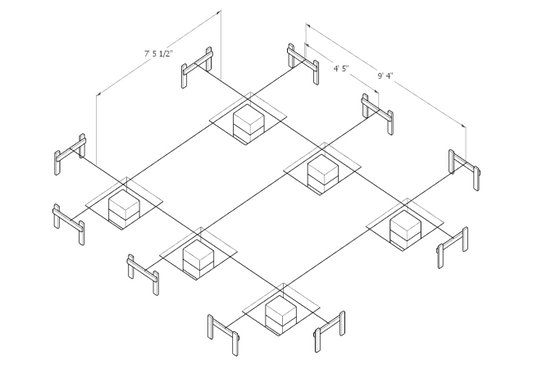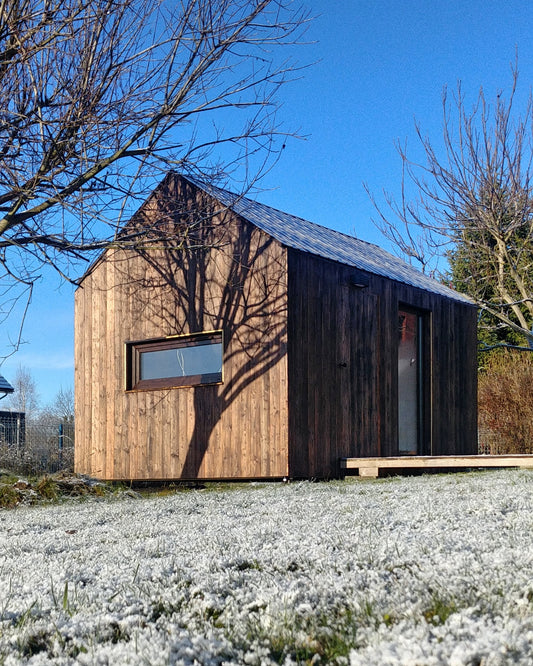
Sauna Wall Insulation
Walls are one of the main building components of an outdoor sauna. In this article, we will discuss everything about sauna walls insulation in depth.
Sauna provides a unique construction technology challenge. Saunas heat up to about 120°C or 248°F ( some people like it even hotter) and there is of course high humidity when we throw water on the rocks.
Ideally, we want to retain as much heat and humidity inside of the sauna. There are two ways to achieve this: use of thick solid timber logs or using a ‘sandwich’ of insulation and membranes in a timber frame wall.
As an architect, I think that the second option has a couple of advantages.
- It limits the amount of wood used to achieve the same results in terms of heat and humidity retention.
- It provides superior U and R values then same thickness solid log construction.
- It allows for thinner walls, thus saving on space.
Sauna wall vapour barrier
To retain moisture inside, we want to use a non-breathable material. Every material has some degree of breathability, but if we want to minimise it, the best would be the foil vapour barrier. In timber frame houses, it is typical to use a thin plastic vapour barrier, but in a sauna, a much better idea is to use Aluminum Vapour Barrier. Aluminium melts at much higher temperature and therefore it will not emit any off gases that could be harmful at a sauna temperature.
The best material and the one I always recommend is a paper - backed aluminium barrier. The paper provides additional support so that Aluminum does not rip during installation, and is non-toxic. Additionally, Aluminum reflects the radiant heat back into the sauna room so that overall it contributes to energy efficiency. Make sure to tape the seams! Otherwise humidity will find its way into the wall cavity. Dam insulation loses its thermal properties.

Taping the seams of the Aluminium Vapour Barrier. Note the extreme focus necessary to do this.
Sauna walls insulation
To keep the heat inside of the sauna, we will want to use insulation. There are many materials that are used to insulate buildings, but just a couple of them work for saunas.
Before we dive into discussing each material individually I want to explain a few terms that might not be known to everyone.
K Value
Materials ability to conduct heat.
Why is it important? Low conductivity is good to keep the heat inside.
Measured in: (W/m*K)
Few examples:
|
Insulating Material
|
Thermal Conductivity (W/m*K)
|
|
Fiberglass
|
0.032-0.044
|
|
Mineral wool
|
0.032-0.044
|
|
Cellulose
|
0.038-0.041
|
|
Polystyrene (EPS)
|
0.032-0.038
|
|
Polyurethane
|
0.018-0.022
|
|
Extruded polystyrene(XPS)
|
0.029-0.038
|
|
Polyisocyanurate
|
0.018-0.023
|
|
Aerogel
|
0.013-0.018
|
|
Polyethylene foam
|
0.030-0.040
|
|
Natural fibers (e.g.wool)
|
0.04-0.06
|
|
Straw bales
|
0.04-0.06
|
R Value
Thermal Resistance between two defined surfaces of a material.
We will need the K value and the material thickness to calculate this. Why is it important? It gives us information on how thick a material should be to meet a certain R value.
The formula is:
R Value = Thickness / K Value
By changing the thickness of a material and therefore of a wall, we can increase or decrease R Value.
|
Material |
Thickness (m) |
K Value (W/m.K) |
R Value |
|
Mineral Wool |
0.05m (2”) |
0.035 |
1.4 |
|
Mineral Wool |
0.1m (4”) |
0.035 |
2.8 |
|
Kingspan Sauna Satu |
0.03 (1.1”) |
0.023 |
2.1 |
|
Natural Fibres |
0.05 |
0.04 |
1.25 |
U Value
U value gives us the rate of heat loss through a given building element ( walls, roof etc.)
Why it’s important: This gives us ‘ totals’ for the whole wall or roof assembly.
Measured in: (W/m²·K)
Formula: U value = 1/(sum of all R values of materials that make up the building element)
Just for reference, the Passive House recommendations specify the U value for a wall to be from 0.10 to 0.15 W/(m²K).
To achieve these values we would have to use more than 20cm (8”) of mineral wool. But because sauna is not a permanent accommodation, there is no problem in using 10mm or 4" of mineral wool.
Great sauna insulating material choices
Mineral Wool (Fibre)
One of the best insulating materials for sauna walls. Melting point of approximately 2150°F (1177°C). Relatively cheap. Comes as a semi rigid board for easy installation. Mineral wool has a 0.035 K value, and a 4" (100mm) thick layer would get us an R Value of 2.8. Refer to the table above to compare it with other materials and thicknesses. R Value of 2.8 is entirely sufficient for an outdoor sauna. It will keep your sauna warm even a day after it has been used. This is very useful if you have a shower inside. Water can freeze below freezing temperature and destroy your pipes.
Example: Auralex 4MF24 4 Mineral Fiber Insulation
(Affiliate link. We may get a small commission if you end up buying this product.)

Good Sauna insulating material choices
Cellulose
I would consider this to be an OK material because it has both positive and negative aspects. Cellulose is one of the most environmentally friendly choices. It is made from fine paper and wood fibres. The drawback is that when it absorbs moisture, it loses its insulating properties. It's relatively fireproof because of the added sodium.
Straw Bales Insulation
Straw bale is an interesting option for those seeking to make their sauna low on CO2 footprint. Relatively cheap. It might be difficult to find a supplier or a contractor willing to use it. I am yet to hear about this type of insulation being used in a sauna
Hemp Sauna Insulation
Hemp is another natural insulating material. Similarly to Straw Bale and Cellulose, it is prone to hold moisture. If you do a good job with taping the seams of your vapour barrier, it would work.
Natural Fibers Sauna Insulation (cotton, wool)
Come in rolls or batts, depending on manufacturer, in thickness of 50mm ( 2”) or 100mm(4”), with widths of 400 mm (16 “) and 600 mm (24”). It is not harmful in any way and does not cause irritation.
It is significantly more expensive than other types like Mineral wool or fibreglass. Sheep wool is often treated with borax to enhance its fire retardant and pest repellent qualities.
Not so good insulating material choices
Polyurethane
Most often in the form of Spray foam. Just like other types of foam insulations, Polyurethane uses blowing agents and flame retardants that are potentially harmful.
Polyisocyanurate
Also known as ‘PIR’ is a thermoplastic produced as a foam and used as rigid insulation. A 2011 study at the University of Central Lancashire Centre for Fire and Hazard Science concluded that PIR “generally released a considerably higher level of toxic products than the other insulating materials studied (PIR > PUR > EPS > PHF; glass and stone wools also studied)” This effectively rules this material out.
Can sauna walls be made from Glass?
Short answer: Yes. Glass walls are a trend that is very popular recently in the sauna world. Is an extremely durable material. It can work as a way to bring the outside in, to connect us with nature, or to make the space appear bigger. It does however have a couple of drawbacks.
- It is prone to breaking in heavy traffic areas.
- Glass has poor insulating properties, therefore it causes heat loss
I would advise to add glass to your sauna if you want to take advantage of views, or connection with the outside.
Is air gap behind the interior wood panelling in a sauna necessary?
Yes. Air gap helps to keep the wood well preserved for a long time. Some wood species like cedar are more durable than other types like pine, aspen or spruce, but it is generally a good construction practice to allow the wood to be ventilated from both sides.
How thick should sauna insulation be?
Assuming you will use Mineral Wool for sauna insulation, the most optimal thickness should be 100mm, or 4”. This thickness will be entirely sufficient for an outdoor sauna. If you live in an area where temperatures drop to -20/30 Celsius ( sub 0 Fahrenheit), consider going with 150mm or 6 inches of insulation.
Why is sauna insulation important?
Sauna wall insulation helps minimize the cost of running a sauna in the long term. Sure, there are tent saunas that people successfully use and reach sauna temperatures, but they do require more fuel / electricity. If you decide to build your sauna from scratch, the cost of insulation is minimal so it is definitely a well spent money.
In closing
To get the best value for money and great performance, for your outdoor sauna walls, use a Mineral wool rigid board of 100mm ( 4”) and use a proper Aluminium vapour barrier. Tape the seams!




3 comments
Would these recommendations apply to the freezing temperatures of Canada? Specifically, Calgary Alberta, with temps in winter below 30 C? I bought rockwool safe and sound insulation but not sure if this will be sufficient for an outdoor sauna? I see many recommendations for r14 in the walls and more for the ceiling. Thoughts? Great article!!!
Great content! Thanks for sharing. I will more than likely use this for training my crew if i can use it. insulation installation
Bardzo szczegółowy artykuł. Zastanawiam się nad ociepleniem ścian i sufitu sauny wełną drzewną Steico termin dry – czy to będzie dobry pomysł?